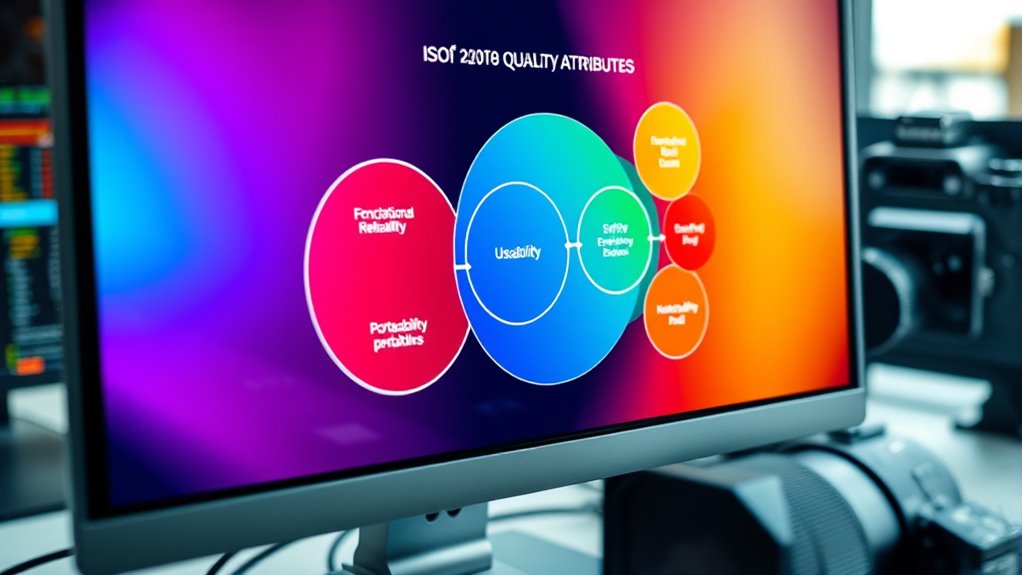According to ISO 25010 standards, key software quality attributes include maintainability, reliability, usability, security, and performance. These attributes help make sure your software meets user needs, stays dependable, and remains easy to update or troubleshoot. Focus on designing for a balance between user experience and manageability. Understanding these attributes helps you create high-quality, sustainable software. To learn more about each attribute and how they work together, keep exploring these essential concepts further.
Key Takeaways
- ISO 25010 defines key software quality attributes including functionality, reliability, usability, efficiency, maintainability, and portability.
- Maintainability ensures software can be easily modified, updated, and extended with clear, modular design and thorough documentation.
- Usability focuses on user-centered design, ensuring intuitive interfaces, consistency, and positive user experiences.
- Reliability involves the software’s ability to perform consistently under expected conditions, minimizing failures and errors.
- Efficiency relates to optimal resource use, ensuring performance standards are met without unnecessary resource consumption.

When developing software, understanding the key quality attributes is essential to guarantee your product meets users’ expectations and performs reliably. Among these attributes, software maintainability stands out because it directly impacts how easily you can update, troubleshoot, and extend your application over time. If your software is maintainable, you’ll save time and resources in the long run, reducing the risk of bugs piling up or features becoming obsolete. You should design with maintainability in mind from the start by writing clear, modular code and documenting your work thoroughly. This not only makes future modifications smoother but also ensures that new team members can quickly get up to speed. Additionally, considering user experience considerations is equally important; users expect intuitive, seamless interactions. When your software is easy to use and responsive, it enhances satisfaction and encourages continued engagement. To achieve this, focus on simplicity in design, consistency in interface elements, and minimizing friction points that could frustrate users. Keep accessibility in mind to accommodate a broader audience, and test your interface regularly to identify and fix usability issues. Incorporating problem-solving skills during testing can help identify root causes of usability problems more effectively. Balancing these attributes can be challenging but essential. For example, a feature-rich application might become complex and harder to maintain if not properly structured, which could negatively influence user experience. Conversely, overly simplified interfaces might compromise functionality, leading to frustration. Hence, you need to strike a balance—designing your software so it remains manageable while still offering a compelling user experience. Incorporate feedback loops during development, involving actual users whenever possible, to understand their needs and pain points. This real-world insight helps you prioritize refinements that enhance usability without sacrificing the maintainability of your codebase. Remember, the goal is to create software that is sustainable over time, adaptable to change, and delightful for users. By emphasizing both maintainability and user experience considerations, you set a strong foundation for delivering high-quality software that stands the test of time and genuinely meets the needs of its users.
Frequently Asked Questions
How Do ISO 25010 Standards Compare to Other Quality Models?
You’ll find ISO 25010 standards focus on holistic quality attributes, making trade-off analysis clearer and more structured. Unlike other models, they emphasize compliance standards, ensuring your software meets international benchmarks. This helps you balance usability, performance, and security effectively. Compared to more specialized models, ISO 25010’s broad scope offers a versatile framework, guiding you through quality assessment and improvement with consistency and clarity, especially when managing complex trade-offs.
Can Quality Attributes Conflict With Each Other? How to Balance Them?
Yes, quality attributes can conflict. You need to perform trade-off analysis to identify these conflicts and understand their impact. Prioritization strategies help you decide which attributes to emphasize based on project goals and user needs. By balancing these trade-offs actively, you guarantee that no single attribute undermines overall quality. Regularly reviewing and adjusting priorities keeps the project aligned with evolving requirements, maintaining peak quality across key attributes.
Are There Industry-Specific Quality Attribute Priorities?
Yes, industry-specific quality attribute priorities vary based on industry trends and user expectations. For example, in healthcare, reliability and security are top concerns, while in gaming, performance and user experience take precedence. You should tailor your focus accordingly, balancing attributes to meet the unique demands of your industry. Staying updated on trends and understanding your users’ needs will help you prioritize quality attributes effectively, ensuring your software remains competitive and meets expectations.
How to Measure Subjective Quality Attributes Objectively?
Ever wonder how you can measure subjective quality attributes objectively? You can achieve this by combining user experience metrics like satisfaction surveys and task success rates with stakeholder perception data. Using tools like Net Promoter Scores or usability testing results helps quantify feelings and opinions into actionable insights. Don’t you want to turn subjective impressions into clear, measurable indicators that drive better software quality? Effort and precision make it possible.
What Role Do Quality Attributes Play in Agile Development?
In agile development, quality attributes guide your focus on delivering a better user experience and higher customer satisfaction. You prioritize features that enhance usability, performance, and reliability, ensuring the product adapts quickly to changing needs. By continuously evaluating these attributes during iterations, you can identify issues early, improve the product incrementally, and ultimately create software that meets users’ expectations and drives satisfaction.
Conclusion
Understanding these key software quality attributes isn’t just helpful — it’s essential for building flawless software. By focusing on factors like usability, reliability, and security, you can create products that stand out in a crowded market. Ignoring these standards is like sailing a ship without a compass — chaos awaits. Mastering ISO 25010 guarantees your software isn’t just good, but truly exceptional, transforming your projects into legendary successes that leave a lasting impact.









